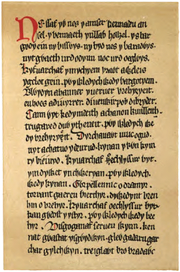Red Book of Hergest
| Red Book of Hergest Llyfr Coch Hergest |
|
|---|---|
| Jesus College, Oxford, MS 111 | |

Facsimile of part of column 579 from the Red Book of Hergest
|
|
| Date | shortly after 1382 |
| Scribe(s) | Hywel Fychan and two other scribes |
| Patron | Hopcyn ap Tomas |
| Material | vellum |
| Size | 34 x 21 cm; 362 leaves |
| Condition | leaves missing at the end; no original binding |
| Contents | early Welsh poetry of the Cynfeirdd and especially, that of the Gogynfeirdd; the Mabinogion; Brut y Brenhinedd; remedies associated with Rhiwallon Feddyg; etc. |
The Red Book of Hergest (Welsh: Llyfr Coch Hergest, Jesus College, Oxford, MS 111) is a large vellum manuscript written shortly after 1382, which ranks as one of the most important medieval manuscripts written in the Welsh language. It preserves a collection of Welsh prose and poetry, notably the tales of the Mabinogion and Gogynfeirdd poetry. The manuscript derives its name from the colour of its leather binding and from its association with Hergest Court between the late 15th and early 17th century.
The manuscript was written between about 1382 and 1410. One of the several copyists responsible for the manuscript has been identified as Hywel Fychan fab Hywel Goch of Buellt. He is known to have worked for Hopcyn ap Tomas ab Einion (c. 1330 – after 1403) of Ynysforgan, Swansea, and it is possible that the manuscript was compiled for Hopcyn.
According to scholar Daniel Huws, it is "by far the heaviest of the medieval books in Welsh, the largest in its dimensions [...] and the thickest".
The manuscript appears to have been retained by Hopcyn's family until the end of the 15th century, when Hopcyn's grandson Hopcyn ap Rhys was held complicit in the rebellion against King Edward IV and consequently saw much of his property forfeited. The Vaughans of Tretower (Tretŵr), then in Breconshire, obtained it, probably in 1465 on receiving Hopcyn's forfeited possessions. Ownership is suggested by two odes (awdlau) dedicated to Sir Thomas Vaughan (d. 1483) and his sons, which were written into the manuscript by Welsh poet Lewys Glyn Cothi at Tretower. The Red Book soon passed into the possession of the Vaughans of Hergest Court, near Kington in the Welsh Marches. Sir John Price of Brecon reports to have seen the manuscript in 1550, presumably at Hergest. In the late 1560s, William Salesbury found the manuscript in the possession of Sir Henry Sidney at Ludlow, when Siancyn Gwyn of Llanidloes held it on loan from him.
...
Wikipedia
